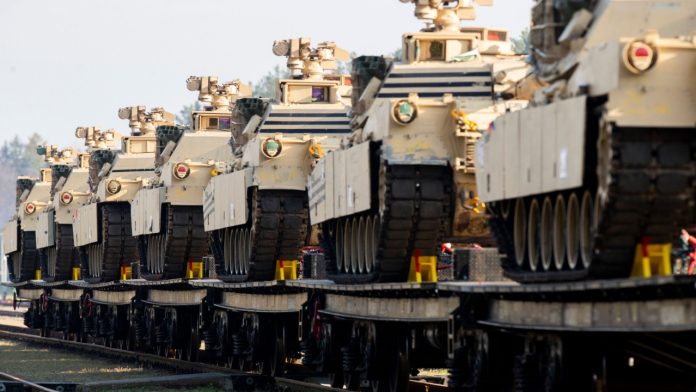Last year, Australia committed to supplying forty-nine M1A1 Abrams tanks to Ukraine. However, these vehicles remain stranded in Poland because a US-managed transfer facility has experienced delays.
Since the Second World War, military strategists have debated whether Germany’s delay in launching Operation Barbarossa—the invasion of the Soviet Union—contributed to its failure to reach Moscow before winter. Heavy rains left the terrain impassable, forcing German forces to wait in Poland.
A similar situation is now unfolding. The Australian government donated M1 Abrams main battle tanks (MBTs) to Ukraine, but they could remain in Poland instead of reaching their destination, where they are urgently needed.
Australia’s support for Ukraine
Australia pledged forty-nine M1A1 Abrams, valued at approximately $245 million, as part of its broader support for Ukraine. This donation coincided with the Australian Defence Force’s transition to seventy-five upgraded M1A2 Abrams tanks, featuring the Systems Enhancement Package Version 3 (SEPv3).
However, transferring the retired M1A1 Abrams tanks has proven complex. Australia needed US approval under the International Traffic in Arms Regulations (ITAR). Despite the Biden administration previously supplying Ukraine with thirty-one of the same tanks in 2023, the process still required additional approvals. Canberra formally notified Washington in September 2024, expecting no major delays.
Logistical challenges affecting the deployment of Abrams tanks
According to the Australian Broadcasting Corporation, issues at a US-funded logistics hub in Poland have caused the delay. The tanks must be processed there before moving to Ukraine.
This facility in Rzeszów handles about 80 per cent of Western military aid for Ukraine. However, recent withdrawals of US military logistics personnel have slowed operations, raising concerns about when the Australian Abrams will be ready for deployment.
Suitability and readiness concerns
Before approving the donation, some Pentagon officials questioned whether the M1 Abrams suited the Ukrainian battlefield. The cost and complexity of maintaining these tanks in Ukraine may have contributed to Washington’s lack of urgency in facilitating their transfer.
A US official, speaking anonymously, said the American government had advised Australia against donating the tanks for these reasons. Despite this, Canberra proceeded with the donation, reinforcing its commitment to Ukraine’s defence.
The future of Australian Abrams tanks in Ukraine
Processing the tanks for combat should not be overly complicated. The US military established a facility in Powidz, Poland, to train and support the Polish Armed Forces in operating Abrams tanks. The Army Preposition Stocks-2 (APS-2) site, located 250 miles from Ukraine’s border, includes 650,000 square feet of warehouse space for armoured vehicle maintenance.
The US Army maintains pre-positioned stock sites in several regions, including six in Europe. The Powidz APS-2 facility, the only one east of Berlin, could shorten NATO deployment times from over sixty days to just one week.
However, given political uncertainties, the Australian M1 Abrams tanks will likely not be processed there. As a result, they may remain in Poland for an extended period.
Frustration among Australian officials
The delay has frustrated Australian defence officials. Major General Mick Ryan of the Australian Army suggested alternative solutions, stating, “If the US military system isn’t able to move these things in a timely fashion, we should be looking at working with our Polish partners or even private contractors—considering security concerns—to ensure these tanks reach Ukraine as soon as possible.”
For now, the Australian-donated Abrams remain in Poland, awaiting further action.
